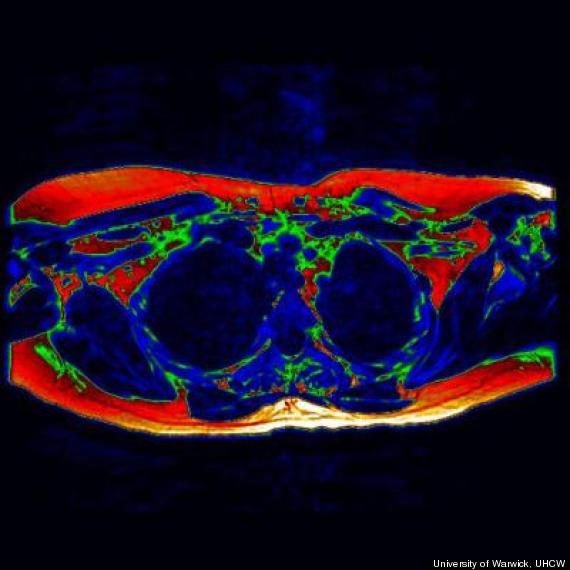
A digitally-enhanced axial MRI of the upper chest (as if viewed from the feet). Areas of potential brown fat are shown in green.
In the world of brown fat news, this is kind of a big deal.
Researchers for the first time have been able to capture evidence of brown fat in a living adult via MRI (magnetic resonance imaging), which is an important step in learning how to activate its powers for weight loss.
"The MRI allows us to distinguish between the brown fat, and the more well-known white fat that people associate with weight gain, due to the different water to fat ratio of the two tissue types," study researcher Thomas Barber, Ph.D., of the Department of Metabolic and Vascular Health at Warwick Medical School, said in a press release. "We can use the scans to highlight what we term 'regions of interest' that can help us to build a picture of where the brown fat is located."
The results of Barber's study are published in the The Journal of Clinical Endocrinology and Metabolism. Now, the next step is to test out the MRI method on larger groups of people.
Brown fat tissue works by burning up regular fat for warmth. Rodents and human babies have a lot of brown fat to keep them warm, but it wasn't until fairly recently that scientists discovered that some adult humans still have traces of brown fat that burn calories when cold. In fact, leaner people have more brown fat, and it seems to protect them from diabetes, according to Science Now. Obese people, on the other hand, don't seem to have much of it at all, reports the New York Times.
In the past, researchers have relied on PET (positron emission tomography) to locate brown fat in human beings. PET scans work by injecting subjects with a special kind of glucose that binds to the areas you want to study (see photos of brown fat PET scans). Then subjects lay down and are placed in an imaging machine to locate the glucose, which is clinging to the brown fat.
The catch with PET scans is that the brown fat has to be metabolically active for the glucose to bind to the tissue, which means that scientists have to cool subjects down to the point that the brown fat starts burning up normal fat for warmth. The new MRI technique captures both active and inactive brown fat, so scientists can have a more accurate picture of where it's all located.